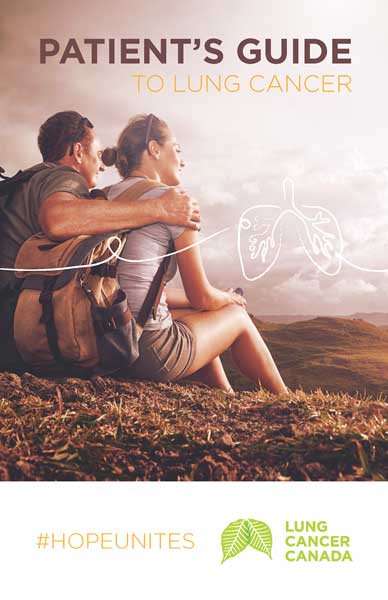Resource Center
Despite being the number one cancer killer in Canada, outcomes in lung cancer lag behind other cancers. Our resource centre was created to give an initial understanding of your lung cancer diagnosis.
Get the Facts
- Lung cancer is the most commonly diagnosed cancer in Canada. It kills more than 21,000 Canadians every year — more people than colorectal, breast, and prostate cancers combined.
- Lung cancer is in fact many diseases, requiring different treatment approaches and therapeutic options.
- Scientific advancements are transforming the treatment of lung cancer. The development of immuno-oncology and targeted treatments offer new weapons in the battle against lung cancer.
- It can take 18-24 months for a life changing treatment option to be publicly reimbursed
Understanding Cancer Survivorship
The reality of a cancer diagnosis is that cancer is a lifelong journey. As a patient or a caregiver, cancer can impact you for the rest of your life.
While the five-year survival rate for lung cancer is only 17%, lung cancer survivorship is improving with new innovative therapies coming to market.
Lung cancer survivorship is complex and the definition of survivorship itself differs from person-to-person. It is important to develop a survivorship and care plan between the patient, the care team, and the primary doctor to promote cooperation between the overall unit.
The Canadian Cancer Survivor Network has some great resources on living with lung cancer after the initial shock of your diagnosis, caregiving resources, and survivorship. Click here for more information.
What does Lung Cancer mean?
Lung cancer is the second most common cancer diagnosis in Canada, but is the number one cancer killer: it kills at least two times more Canadians than any other cancer.
The current outlook for most lung cancer patients is not encouraging; 85 percent of Canadians diagnosed with lung cancer will not live five years. It is our hope that we can help change these statistics.
Right now, treatment options for lung cancer patients are lagging behind in Canada. The Right2Survive campaign aims to bring greater awareness of this disease to Canadians to help fight for lung cancer patients’ right to survive. We hope our advocacy will spread a better understanding of lung cancer; destigmatize the disease; push for greater research to be done in the area; give lung cancer patients better information on their options; push for better and more accessible screening programs; and ultimately bring innovative treatments to market so more patients can beat the odds.
Types of Lung Cancer
Lung cancer begins when abnormal cells begin to form in the lung and exponentially grow. As more cancer cells grow, they can form into a tumour and can spread to other areas of the body.
There are two types of lung cancer:
Non-small cell lung cancer (NSCLC)
Makes up approximately 80-85 per cent of lung cancers. It grows more slowly than SCLC. There are three different types of NSCLC:
- Adenocarcinoma
- Squamous cell (epidermoid) carcinoma
- Large cell (undifferentiated) carcinoma
Small cell lung cancer (SCLC)
Makes up approximately 10-15 per cent of lung cancers. SCLC almost always begins in the bronchi (the airways of the chest).
SCLC grows quickly and often spreads to different parts of the body. It is less likely to be caught at earlier stages. SCLC is composed of much smaller cells and can quickly become fatal if left untreated.
Download Our Patient's Guide
We know you have questions. This Patient Guide was written and produced in its entirety by Lung Cancer Canada to meet the information needs of patients and caregivers. It is up-to-date and represents current practices in Canada.
